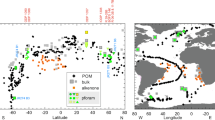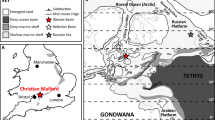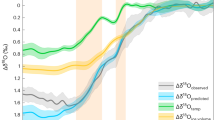Abstract
Determining the past record of temperature and salinity of ocean surface waters is essential for understanding past changes in climate, such as those which occur across glacial–interglacial transitions. As a useful proxy, the oxygen isotope composition (δ18O) of calcite from planktonic foraminifera has been shown to reflect both surface temperature and seawater δ18O, itself an indicator of global ice volume and salinity1,2. In addition, magnesium/calcium (Mg/Ca) ratios in foraminiferal calcite show a temperature dependence3,4,5 due to the partitioning of Mg during calcification. Here we demonstrate, in a field-based calibration experiment, that the variation of Mg/Ca ratios with temperature is similar for eight species of planktonic foraminifera (when accounting for Mg dissolution effects). Using a multi-species record from the Last Glacial Maximum in the North Atlantic Ocean we found that past temperatures reconstructed from Mg/Ca ratios followed the two other palaeotemperature proxies: faunal abundance6,7 and alkenone saturation8. Moreover, combining Mg/Ca and δ18O data from the same faunal assemblage, we show that reconstructed surface water δ18O from all foraminiferal species record the same glacial–interglacial change—representing changing hydrography and global ice volume. This reinforces the potential of this combined technique in probing past ocean–climate interactions.
This is a preview of subscription content, access via your institution
Access options
Subscribe to this journal
Receive 51 print issues and online access
$199.00 per year
only $3.90 per issue
Buy this article
- Purchase on Springer Link
- Instant access to full article PDF
Prices may be subject to local taxes which are calculated during checkout




Similar content being viewed by others
References
Shackleton, N. J. Attainment of isotopic equilibrium between ocean water and the benthonic foraminiferal genus Uvigerina: isotopic changes in the ocean during the last glacial. Cent. Nat. Rech. Sci. Colloq. Int. 219, 203–209 (1974).
Rostek, F. et al. Reconstructing sea surface temperature and salinity using δ18O and alkenone records. Nature 364, 319–321 (1993).
Nürnberg, D. Magnesium in tests of Neogloboquadrina pachyderma sinistral from high northern and southern latitudes. J. Foram. Res. 25, 350–368 (1995).
Nürnberg, D., Bijma, J. & Hemleben, C. Assessing the reliability of magnesium in foraminiferal calcite as a proxy for water mass temperature. Geochim. Cosmochim. Acta 60, 803–814 (1996).
Lea, D. W., Mashiotta, T. A. & Spero, H. J. Controls of magnesium and strontium uptake in planktonic foraminifera determined by live culturing. Geochim. Cosmochim. Acta 63, 2369–2379 (1999).
CLIMAP. Seasonal reconstruction of the Earth's surface at the last glacial maximum. Geol. Soc. Am. Map Chart Ser. MC-36, 1–18 (1981).
Mix, A. C., Morey, A. E., Pisias, N. G. & Hostetler, S. W. Foraminiferal faunal estimates of paleotemperature: circumventing the no-analog problem yields cool ice age tropics. Paleoceanography 14, 350–359 (1999).
Müller, P. J., Kirst, G., Ruhland, G., von Storch, I. & Rosell-Melé, A. Calibration of the alkenone paleotemperature index UK′37 based on core-tops from the eastern South Atlantic and the global ocean (60° N–60° S). Geochim. Cosmochim. Acta 62, 1757–1772 (1998).
Lear, C. J., Elderfield, H. & Wilson, P. A. Cenozoic deep sea temperatures and global ice volumes. Science 287, 269–272 (2000).
Delaney, M. L., Bé, A. W. H. & Boyle, E. A. Li, Sr, Mg and Na in foraminiferal calcite shells from laboratory culture, sediment traps, and sediment cores. Geochim. Cosmochim. Acta 49, 1327–1341 (1985).
Rosenthal, Y., Boyle, E. A. & Slowey, N. Temperature control on the incorporation of magnesium, strontium, fluorine and cadmium into benthic foraminiferal shells from Little Bahama Bank: prospects for thermocline paleoceanography. Geochim. Cosmochim. Acta 61, 3633–3643 (1997).
Hastings, D. W., Russell, A. D. & Emerson, S. R. Foraminiferal magnesium in Globigerinoides sacculifer as a paleotemperature proxy. Paleoceanography 13, 161–169 (1998).
Mashiotta, T. A., Lea, D. W. & Spero, H. J. Glacial-interglacial changes in Subantarctic sea surface temperature and δ18O using foraminiferal Mg. Earth Planet. Sci. Lett. 170, 417–432 (1999).
Ganssen, G. M. & Kroon, D. The Isotopic Signature of Planktonic Foraminifera from Northeast Atlantic Surface Sediments: Implications for the Reconstruction of Past Oceanic Conditions (Special Publication, Geological Society, London, in the press).
Levitus, S. & Boyer, T. World Ocean Atlas 1994 Vol. 4, Temperature (NOAA Atlas, National Environmental Satellite Data and Information Service Vol. 4, US Department of Commerce, Washington DC, 1994).
Rosenthal, Y. & Boyle, E. A. Factors controlling the fluoride content of planktonic foraminifera: an evaluation of its paleoceanographic utility. Geochim. Cosmochim. Acta 57, 355–346 (1993).
Brown, S. J. & Elderfield, H. Variations in Mg/Ca and Sr/Ca ratios of planktonic foraminifera caused by post-depositional dissolution: evidence of shallow Mg-dependent dissolution. Paleoceanography 11, 543–551 (1996).
Rosenthal, Y., Lohmann, G. P., Lohmann, K. C. & Sherrell, R. M. Incorporation and preservation of Mg in Gs. sacculifer: implications for reconstructing the temperature and 18O/16O of seawater. Paleoceanography 15, 135–145 (2000).
Chapman, M. R., Shackleton, N. J., Zhao, M. & Eglinton, G. Faunal and alkenone reconstructions of subtropical North Atlantic surface hydrography and paleotemperature over the last 28 kyr. Paleoceanography 11, 343–357 (1996).
Bard, E. Ice age temperatures and geochemistry. Science 284, 1133–1134 (1999).
Schrag, D. P., Hampt, G. & Murray, D. W. Pore fluid constraints on the temperature and oxygen isotopic composition of the glacial ocean. Science 272, 637–642 (1996).
Acknowledgements
We thank M. Greaves and M. Cooper for help with analyses, and D. Nürnberg, D. Lea, Y. Rosenthal, E. Bard, D. Schrag, E. Boyle and N. Shackleton for discussions.
Author information
Authors and Affiliations
Corresponding author
Additional information
Institute of Earth Sciences, Free University, De Boelelaan 1085, 1081 HVAmsterdam, The Netherlands
Rights and permissions
About this article
Cite this article
Elderfield, H., Ganssen, G. Past temperature and δ18O of surface ocean waters inferred from foraminiferal Mg/Ca ratios. Nature 405, 442–445 (2000). https://doi.org/10.1038/35013033
Received:
Accepted:
Issue Date:
DOI: https://doi.org/10.1038/35013033
This article is cited by
-
Last deglacial abrupt climate changes caused by meltwater pulses in the Labrador Sea
Communications Earth & Environment (2023)
-
Iberian Margin surface ocean cooling led freshening during Marine Isotope Stage 6 abrupt cooling events
Nature Communications (2023)
-
Abrupt upwelling and CO2 outgassing episodes in the north-eastern Arabian Sea since mid-Holocene
Scientific Reports (2022)
-
Deglacial Subantarctic CO2 outgassing driven by a weakened solubility pump
Nature Communications (2022)
-
DNA nanostructures as templates for biomineralization
Nature Reviews Chemistry (2021)
Comments
By submitting a comment you agree to abide by our Terms and Community Guidelines. If you find something abusive or that does not comply with our terms or guidelines please flag it as inappropriate.



